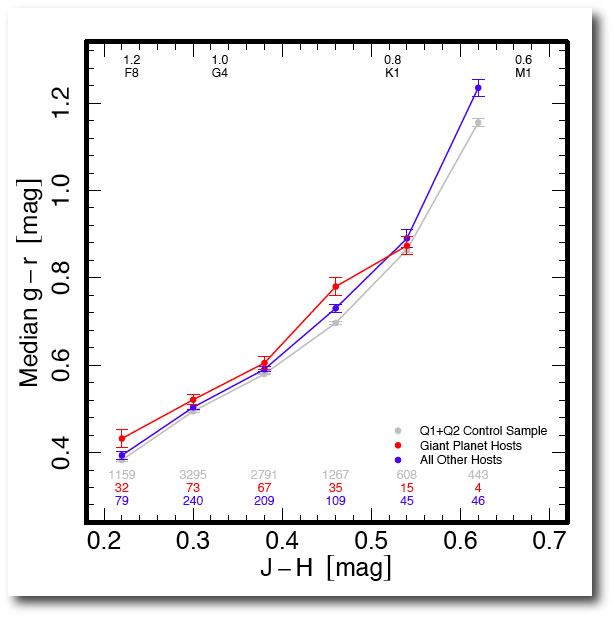A well-known theorem states that there’s no such thing as a free lunch. A corollary is that interesting discoveries tend to be made at the ~3-4 sigma level of confidence, and this is especially true if the supporting data is drawn from the public domain. If a signal is stronger than 4-sigma, then someone else has invariably pointed it out. If it’s weaker than 3-sigma, it’s probably wishful thinking.
With those rules of thumb in mind, I’m very optimistic that Kevin Schlaufman has obtained a genuinely important insight into how the planet formation process works:
The plot shown is above is from a paper that Kevin and I submitted soon after the 1,235 Kepler planet candidates were announced last Spring. After going through review, it was accepted by the ApJ, and it was posted to astro-ph last week.
I wrote about the underlying details of the plot in this post from several months ago. The basic idea is as follows: The 997 Kepler planet candidate host stars are divided up into two groups — (i) the less numerous group of stars that host a candidate with R_pl>5 Earth radii (red), and (ii) the more numerous group of stars that only host a planet (or planets) with R_pl<5 Earth radii (blue). The two groups of stars, along with a control sample of 10,000 non-candidate-bearing dwarf stars from the Kepler field (gray), are plotted in a color-color diagram (and then binned to create the diagram above):

The y-axis corresponds to the magnitude difference between a given star’s green (Sloane g filter) and red (Sloane r filter) colors. The x-axis charts the differences between the 2Mass J and H infrared colors for each star. Metal-rich stars tend to have redder optical colors than metal-poor stars, whereas the J-H index sorts the stars in terms of their overall temperatures (with cool stars to the right and warm stars to the left of the plot). Metal-rich stars thus lie along the upper part of the main-Sequence locus.
The binned version of the plot provides a confirmation of several trends that were already very well known. First, among host stars with masses similar to the Sun that harbor giant planets, there’s a strong preference for metal-rich stars. This is the classic planet-stellar metallicity effect. Second, among low-mass stars, there’s a dearth of giant planet candidates. This is the known giant planet-stellar mass effect. Finally, among the solar mass stars that host low-mass planets, there’s no discernible metallicity correlation.
The new result pertains to low-mass planets orbiting low-mass stars. The diagram shows that for this subset, there’s strong evidence for a metallicity correlation — At masses less than ~0.8 solar masses, higher metallicity stars are more likely to host low-mass planets. We take this as direct evidence regarding the overall bulk efficiency of planet formation for planets that aren’t required to bulk up via rapid gas accretion. Take a 0.7 solar mass with twice the Sun’s metal content and a typical 0.02 solar mass disk. The entire planet-forming disk contains about 150 Earth-masses worth of stuff heavier than hydrogen and helium. Kevin’s result is effectively saying that a good fraction of the time, a good fraction of this total burden of metals winds up in planets.
We had to be careful. There are a lot of systematic “gotchas” that can potentially throw a wrench into the exciting big-picture conclusions, and so much of the paper is devoted to considering potential show stoppers in turn. I think that the result is robust, and that it will hold up as the planet catalog continues to grow.



Is the gap around g-r=1 significant?
A few questions and remarks on this very fascinating topic and post:
– Are the (majority of) giant planet hosts exclusively hosting a giant planet or are part of them hosting both a giant and a smaller planet?
– In view of the still limited Kepler observation time, I presume that the great majority of giant planets are close-orbit giant planets and that the jury is still largely out on the wider orbit giants. Wouldn’t it be more correct then to state in the first mentioned conclusion that there is a strong correlation between (high) metallicity and close-orbit giant planets?
– Same for low-mass stars and lack of giant planets: isn’t this mainly true (so far) for the close-orbit giants? And likewise, the solar mass stars with only lower-mass planets may still have giant planets in wider orbits (?).
– The lack of metallicity correlation for solar mass stars and (only) low-mass planets seems odd when there is such a strong correlation for low-mass stars. What could be the explanation for this? Is there not even a minimum metallicity for the solar mass low-mass-planet host stars (as has been suggested previously)?
– It would be even more interesting to be able to correlate this (low-mass) planet occurrence to specific elements, such as silicon, iron, …, as has been done in the previous post The Silicon Effect. Is anything more specific already known on this?
Well, maybe. But g-r is a really poor metallicity indicator. It seems to me that the plot shown BARELY shows the known metallicity correlations to any reasonable degree of confidence. All of these stars are bright enough to have decent metallicities determined from spectroscopy, and my guess is that such data probably already exists for at least hundreds of the candidate stars. I doubt any spectroscopist is going to put much confidence in this result until such data is published.
Pingback: HARPS: Hunting for Nearby Earth-like Planets